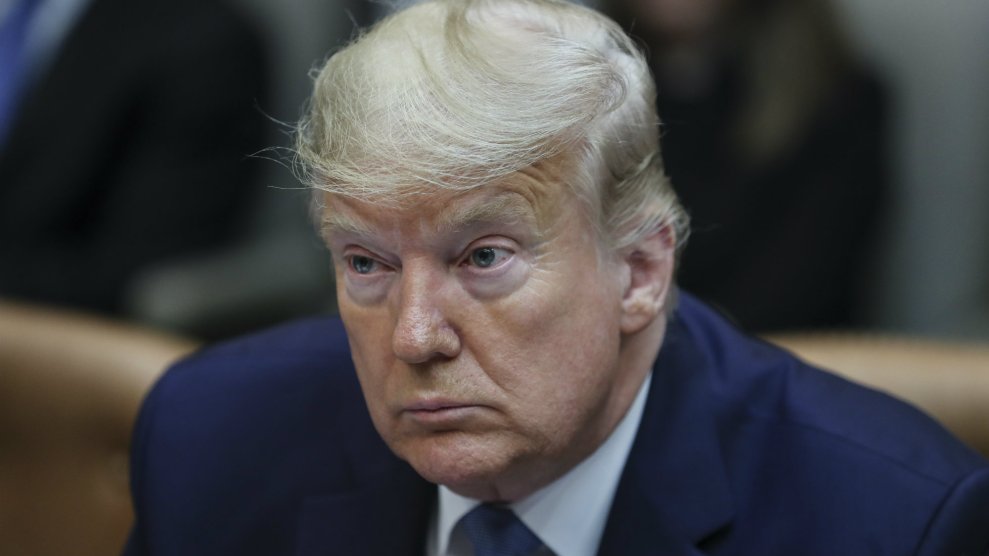
President Donald Trump speaks at a Coronavirus briefing at the White House on Thursday, April 2, 2020. Kevin Dietsch/CNP via ZUMA
On March 8, a group of progressive opinion researchers wrapped up three days of polling American public attitudes on the coronavirus. By March 11, the day Navigator Research released those findings, the World Health Organization officially elevated the crisis to pandemic status, the NBA canceled its season, and Tom Hanks and Rita Wilson announced they had COVID-19. That night, Trump gave an Oval Office address that failed to quell fears, setting off a market spiral the following morning.
“I remember feeling like we did a survey that is already out of date in four days,” says Bryan Bennett, the director of polling and analytics at the Hub Project, a progressive group that houses the Navigator Research project. “The only comparable experience, at least in my career, was during the initial part of the financial crisis. But this was just a whole other level.”
As most Americans’ routines were upended by the virus, so was the political landscape. Even though the November elections were still eight months away, the coronavirus made it clear to progressive operatives and advocates that they had an immediate role to play, and that they could make a big difference by launching ad campaigns that define Trump on the election’s new and biggest question. Health care and the economy, already front-and-center on voters’ minds, were now even more urgent, and tied to a larger debate, the outcome of which will likely determine who occupies the White House next year: Whether President Donald Trump has failed in anticipating and responding to the crisis.
“The narrative Democrats set now forms the prism through which future news will be interpreted,” says Daniel Scarvalone, a digital strategist at the Democratic digital firm Bully Pulpit Interactive. “Not all Americans are going to watch the news and come to their own conclusions that Donald Trump is doing a bad job. They need their elected officials, state or city leaders, and campaigns to draw the connection between the Trump administration’s actions and the fact that their kids can’t go to school. And that’s the fundamental challenge Democrats have to deal with.”
Outside group spending has long had a major role to play in campaigns, and never more so given current campaign finance laws that allow super PACs and dark money groups to collect and spend unlimited sums. Often they play the bad cop, going negative and attacking the politician they oppose while allowing their preferred candidate to stay positive and appear above the fray. In 2012, the Democratic super PAC Priorities USA Action laid into Mitt Romney with ads portraying him as a heartless capitalist who shut down midwestern factories to turn a profit that defined the republican nominee for the rest of the election and helped sink his campaign.
On March 12, a group dedicated to preserving and expanding the Affordable Care Act, called Protect Our Care, released the first political television ad that mentioned the coronavirus. It targeted Sen. Steve Daines (R-MT) for his opposition to Obamacare. Montanans already worried about health care were now also worried about coronavirus, the ad’s narrator intoned.
But Protect Our Care quickly realized that as a group focused on health care, they had a larger role to play, and broadened its messaging to include the country’s biggest contest by setting up what it calls its “Coronavirus War Room,” a messaging hub meant to hold Trump accountable for the ways he has made the crisis worse. Last week, it began blasting off memos targeting Trump to the press while also acting as a messaging clearinghouse for other groups. Protect Our Care also started hosting calls three times a week with progressive groups to get everyone on the same talking points. Brad Woodhouse, the group’s executive director, said that last week’s Wednesday call hit its limit of 100 participants.
“Our focus at Protect Our Care and the Coronavirus War Room is largely on the accountability piece and with that it’s almost exclusively focused on Trump,” says Woodhouse, a longtime Democratic operative. “You can’t wait until October to tell the American people about how roundly he screwed this up.”
Woodhouse sums up the core messages pushed from the war room: “He screwed it up from the beginning, he hasn’t learned from his mistakes, he’s downplayed the crisis, he doesn’t listen to experts, and that continues to make the crisis worse.” You can see the strategy deployed in the emails his team blasts out, often three a day, which attack Trump on a range of issues, including the administration’s failure to prepare by ramping up testing and the manufacture of medical equipment and protective gear; its elimination of key offices and positions charged with pandemic preparedness; and by elevating Trump’s comments, like downplaying the need for ventilators, that contradict medical experts.
Meanwhile, the Trump campaign has been churning out press releases with the opposite message. On March 19, the campaign sent out a timeline of the “Trump administration’s decisive actions to combat the coronavirus,” including travel advisories regarding China and the dissemination of tests—though extensive reporting has shown the administration critically bungled testing for months, leading to a deficit that is still crippling the response. In multiple emails from the campaign’s “Trump War Room,” the campaign points a finger at the media, labeling it “dishonest.” In the past few days, the campaign has claimed that the Obama administration failed to stockpile medical equipment and blaming then Vice President Biden.
The president’s message has been embraced by conservative outlets, most notably Fox News. Like Trump, the network initially downplayed the crisis, with Sean Hannity, its most-watched host, calling the pandemic a hoax. (Nine days later, he falsely claimed he never had.) But eventually, it adopted a shift in tone more in line with public health warnings about the severity of the pandemic, but that nonetheless accommodated pro-Trump messaging. The network has aggressively pushed the anti-Malaria drugs chloroquine and hydroxychloroquine as a possible treatment for COVID-19 just as Trump has done, without mentioning that there is scant evidence to support their use. In the past few days, Fox hosts and guests have also floated the idea on air and in social media posts that claims of overwhelmed hospitals are a conspiracy, circulating grassroots reports of purportedly empty local hospital parking lots and emergency rooms. The network also gave cover to an idea floated by Trump, but quickly-abandoned, that older Americans would be proud to sacrifice their lives to protect the economy for younger people.
“One thing has been clear from the last five years of Trump, which is that he has enough right-wing information channels that even when we think he will implode, he rarely does,” says Jesse Ferguson, a Democratic consultant. “They’re gonna want to crown him the King of Corona like Eisenhower was after D-Day no matter what happens.”
To fight pro-Trump narratives, Democratic message warriors are looking for fresh data on how his words and actions are hitting home amid the crisis. For nearly two years, Navigator Research, which is operated by two progressive polling firms, Global Strategy Group and GBAO Research and Strategy in consultation with the Hub Project, has put out monthly polls to help guide progressive messaging on a variety of issues. Two weeks ago, the project decided to scrap the monthly poll and set up a daily tracker to understand people’s attitudes toward the coronavirus and Trump’s handling of the crisis. “We can’t handle this appropriately in real time as a progressive movement, as Democratic leaders, if we don’t understand how the public is processing it—because it is uncharted territory,” said Ian Sams, a Democratic strategist who consults with the Hub Project and Navigator Research. “We’ve never had 3 million people file for unemployment in a week.” Recent numbers show the situation is even more unprecedented: 10 million jobless benefit claims in two weeks.
Over the last two weeks, the project’s poll has captured data uncovering areas where Trump remains out of step with American opinion. When Trump floated the idea of prioritizing the economy over public health, the tracking poll released last Friday showed that people were more worried about their health and the health of those they know than the economy. Over the course of its first week, the poll showed Americans’ view of Trump’s overall handling of the crisis was trending downward. Small majorities last week believed Trump’s response has been “unprepared” and “chaotic.”
“Voters have deep concern about the character flaws of Donald Trump,” says Ferguson, who, in his work on Hillary Clinton’s 2016 campaign saw such opinions shape that election cycle. “They identify that he’s selfish, that he’s dishonest, and that he’s chaotic. But up until now, those flaws have never had a cost. Up until now people wrote those flaws off as ‘He tweets too much.’ Now, the fundamental character flaws of Donald Trump are having real consequences. That more than anything else may be his undoing.”
Multiple Democratic super PACs have begun to run advertisements on Facebook and on television to hammer this message, though campaign finance law prohibits them from coordinating with progressive groups that are subject to fundraising restrictions. Pacronym, a Democratic super PAC affiliated with the digital firm Acronym, announced on March 17 that it would spend $2.5 million through April on Facebook ads to educate voters about “how the Trump administration’s chaos and incompetence have weakened the nation’s ability to respond to the coronavirus crisis.” The effort is focused on battleground states.
Priorities USA Action, another Democratic super PAC, began running television ads last Tuesday in the swing states of Florida, Michigan, Pennsylvania, and Wisconsin. The ad splices clips of Trump downplaying the crisis with a growing chart showing the rising number of infections in the United States. The Trump campaign issued a cease and desist letter to TV stations asking them to remove the ad; the group responded by putting it on the air in Arizona as well. A version with updated numbers went up this week. On Wednesday, the group spent another $1 million on a television ad that contrasts Trump’s response with remarks Biden has made about how he would handle the crisis. It also began running a Facebook ad juxtaposing Trump and Biden.
“This is the most important issue in the country today,” says Katie Drapcho, Priorities USA Action’s director of research and polling. “I think it’s a defining moment for Trump’s presidency and the country. And our view is that it’s absolutely crucial that voters hear the facts about Trump’s inaction and misleading statements.”
Last week, Unite the Country PAC, a super PAC started in 2019 to support Biden’s campaign, spent $1 million to broadcast an ad accusing Trump of failing in this time of crisis, and added another TV spot on the same theme on Tuesday. “We have a lot of partnerships with organizations on the IE side,” says Drapcho, referring to independent expenditures made by other super PACs, though not naming them. “[We] are making sure that we’re synced up with them as best that we can.” Protect Our Care, the group behind the Coronavirus War Room, launched new ads across Michigan, Wisconsin, and Pennsylvania this week targeting Trump his unprepared response to the crisis.
As this new deluge of ads hits Trump in key states, America First Action, the main super PAC set up to defend Trump, appears to have been caught flat footed. After Trump aides and allies expressed concerns about the lack of air cover backing the president, America First Action announced it would spend $10 million to run television and digital ads attacking Biden in Michigan, Wisconsin, and Pennsylvania, set to begin in mid-April, nearly a month after Democrats began pounding the president.
Messaging is only one piece of what Democratic groups must address to compete effectively through the coronavirus crisis. Earlier in March, the calls run by Protect Our Care included legislative updates from Congress alongside information on public health. Looking forward, the logistics of campaigning during a pandemic loom. It’s one thing to figure out how to attack Donald Trump, it’s another to do so without rallies or door knocking. It’s a problem for the Democratic nominee, but also for organizers behind voter registration and get-out-the-vote programs.
“You have a lot of progressive Democratic groups both rethinking their plans for events over the spring and summer and beginning to write Plan B for their canvas programs and door knocking in the fall,” said a Democratic consultant. “No one is implementing Plan B yet. But lots of people are putting pen to paper, because no one really knows.” Just as social gatherings have transitioned to FaceTime and Zoom, it seems certain that new forms of political organizing will be digitized.
But for now, working from their homes, many Democrats allies see the political response as urgent. Scarvalone, the digital strategist, points to Navigator Research’s finding that over 60 percent of Americans believe Trump was unprepared for the crisis. “But it isn’t yet translating into an equal percentage of people who hate how he’s handling it,” he says.
“We lose if we don’t make the consequences of his actions tangible to everyday people.”















